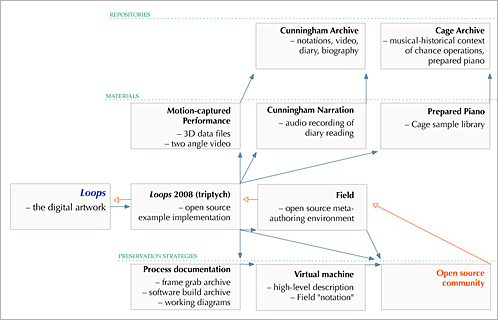LOOPS CULTURAL ECOLOGY
ECOLOGY
It is a convenient fiction that completed artworks exist in perfect and isolated purity, framed for eternity. But the truth is more entangled than that, for artworks both grow from, and survive within, what you might call a cultural ecology. And this ecology is itself a moving target: it is an intricate system of balances and inter-dependencies that evolves (or devolves) over time.
The cultural ecology for Loops is a good case in point for it is under constant threat. As a dance, can it outlive the now-88-year-old who is its sole performer? As a digital artwork, can it survive the rapid obsolescence of its hardware and software?

A map of this ecology is our best guide here. A larger, more legible version may be found in pdf form here What follows is an explanation of each of the map’s key areas.
THE DIGITAL ARTWORK
Loops 2008 (triptych)
An example (re)implementation of Loops is released as open source. This reimplementation of the original 2001 and 2005 versions of Loops has transferred it to an alternative operating system platform (Macintosh vs. PC) and alternative graphics library (OpenGL vs. DirectX).
Field authoring platform
Loops was re-implemented in Field, the OpenEnded Group’s new environment for digital artmaking, which is also being released as open source. The capabilities of Field are much broader than what is required for Loops ; the code has been developed over the last five years and underpins all our recent projects, which span diverse fields and media. More information on Field may be found here.
PRESERVATION STRATEGIES
The re-implementation of Loops has been precisely documented in three ways:
- frame grab archive – a collection of the stills was automatically saved every 20 seconds during the design of the work
- software build archive – every build of Field’s code is automatically preserved, time-stamped, and annotated
- working diagram collection – rough conceptual diagrams sketched during the making of the work are re-set for preservation as pdfs.
The “virtual machine” specification.
The need to recompile the source code ties Loops to a particular machine architecture, a particular programming language, and a particular set of operating system interface, each of which possesses its own, very finite, life-span. To abstract Loops from its implementation we provide a human-readable, high-level description of the Loops and the Loops Score architectures: their core algorithms and logic. This is a description, essentially, of the language that is used to express this work, freed from the particularities of the existing programming languages originally used to implement Loops.
Open source community
By releasing our code as open source, we seek to share it with others in hopes that they will become invested in using the same tools that we do – and indeed to expanding and refining those tools. If a broad community takes up our approach, then the likelihood of Loops’ survival and evolution becomes far greater than if we were to try safeguarding it exclusively.
MATERIALS: MOTION CAPTURE DATA
Motion-capture Data
The motion-captured performance is the original source data-files obtained in the original motion capture session with Cunningham. Together with a description of the file formats in which they are stored (.htr, .fbx, and proprietary), these files enable a three-dimensional reconstruction of the performance.
Voice-over audio
The Cunningham narration is the audio, and the segmented transcription of that audio, of the recording session of Cunningham reading from his diary.
Prepared piano sample library
The prepared piano sample library, recorded by the Cage Trust, forms the source audio palette for Loops Score , the music to Loops. Our “extended pianos” are a set of digital reconfigurations of this prepared piano. The source samples are time-stretched, re-pitched, blended, and assigned to different ranges of the piano keyboard to form nine alternative prepared instruments that exist only digitally.
REPOSITORY
This work can be connected with the wider contexts of Cunningham’s work, to be found in the archives of both Merce Cunningham and John Cage, both now in the collection of the New York Public Library for the Performing Arts. Visually, to the dance-historical context of the original 1970s Loops choreography; musically, to the music-historical context of the Cage prepared piano. Historically, Cunningham’s narration links back to his diary and notebooks; and Loops Score, with its extensive use of probablistic methods and its digital recreation of a prepared piano, links back to the Cage archive, where Cage’s canonical use of chance operations in music may be explored.